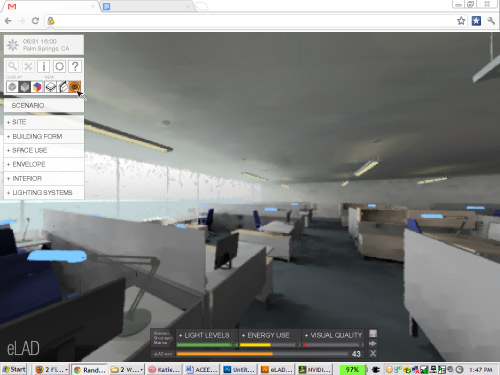e Lighting and Daylighting (eLAD)
Project Overview
Running parallel to our LGB project, this $1.5-million grant through Lawrence Berkeley National Laboratory (LBNL) for the US Department of Energy, the Lighting and Daylighting project focuses on developing a software platform exclusively for these two building systems. The eLAD and LGB projects are collaborating informally with the intent of allowing the graphic user interfaces (GUIs) and data structures to be compatible across the programs. While the LGB project will focus on a whole-building integrated eLearning environment, the eLAD project will develop features for lighting and daylighting systems in more detail.

Project Website
http://elad.su-per-b.org
More About This Project
SuPerB is managing this LBNL project which is addressing specific lighting and daylighting requirements for the following modules or elements of the National Weatherization Training Platform (NWTP) and a now being developed:
- • pedagogy
- • curriculum development
- • virtual environments
- • dynamic 3D environments
- • computer simulation engines
- • game-based learning engines
- • content management modules & content
- • Learning management systems (LMS)
- • data structures and data bases
- • question generation & answering modules
- • social / communication / collaboration tools
- • learner performance modeling & evaluation
- • evaluations / assessments of the eLearning system.
In 2010, a lighting & daylighting curriculum summer session at LBNL was designed to lay the foundation for an effort that will extend into 2011 with the release of a prototype eLearning software platform. The session has several objectives:
- • To develop a basic set of educational content that will be usable within the planned eLearning Platform for Lighting and Daylighting (eLAD). One source of content would be to use public domain or open source material that can be freely distributed with the software platform, remixed and reissued.
- • To identify the current sets of energy-related curricula being used within various educational programs for lighting and daylighting. Such programs might include but not be limited to: 2-year programs, 4-year programs, and continuing education programs sponsored by professional societies, utilities, unions, and others.
- • To establish a portal, and a plan for maintaining it as a national/international focal point for obtaining and distributing information about curricula and educational content for lighting and daylighting. Alternately the summer institute may collaborate to support and enhance one or more existing portals.
- • To develop a plan for increasing the range and depth of available open educational resources on energy-related aspects of lighting and daylighting. This would include emphasis on enhancing visual quality while reducing energy use.
- • The summer institute will also focus on the potential of linking current curricula, across a wide range of copyright perspectives, with the National Weatherization Training Platform (NWTP), the eLAD, and other similar platforms and tools.
Learning Objectives
- • Understand factors involved in "good" lighting and daylighting.
- • Acquire the skills needed to carry out both time specific and annual lighting, daylighting and glare analysis of typical spaces.
- • Learn key basic principles and application concepts for luminance, illuminance, contrast ratios, glare, & visual comfort.
- • Learn about lighting and daylighting control concepts, technologies, and specification issues and techniques.
- • Learn how recognize when lighting/ daylighting systems are functioning properly
- • Learn how to troubleshoot problematic systems
- • Recognize how to improve and/or influence design decisions directly based on this analysis.
- • Review current research trends and challenges
